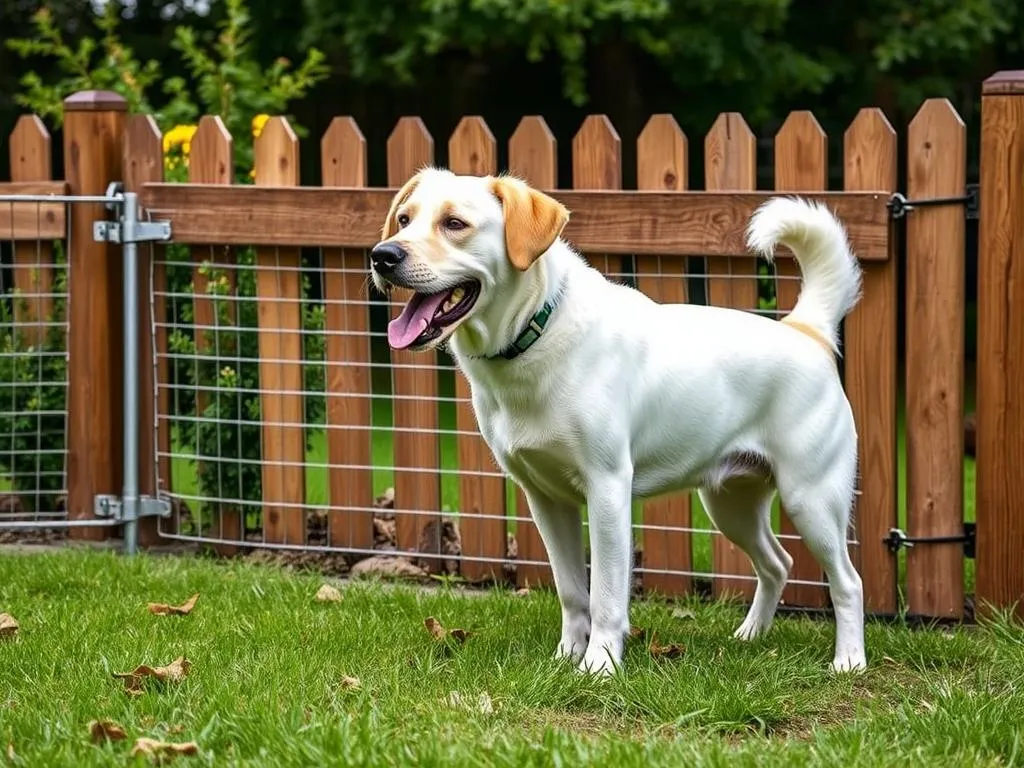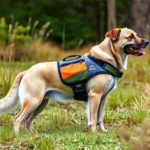
Keeping our furry friends safe is an essential responsibility for any dog owner. A dog-proof fence is a critical aspect of ensuring that your pet remains secure in your yard while protecting them from potential dangers outside. This guide will explore the various ways to effectively dog-proof your fence, addressing common challenges and providing practical strategies tailored to your dog’s needs.
Understanding Your Dog’s Behavior
Common Escaping Behaviors
Dogs are inherently curious creatures, and their desire for exploration can often lead them to escape their fenced areas. Understanding common escaping behaviors is crucial to dog-proofing your yard effectively.
- Jumping: Many dogs, especially high-energy breeds, can easily leap over a standard fence.
- Digging: Dogs may dig under the fence, particularly if they are trying to chase after something or simply bored.
- Climbing: Some dogs are adept climbers and can scale fences that lack proper design features to deter such behavior.
Assessing Your Dog’s Size and Breed
Different breeds have varying tendencies when it comes to escaping. For instance, a Greyhound may require a taller fence due to their jumping abilities, while a Dachshund might be more inclined to dig. Understanding your dog’s size and breed is fundamental in choosing the right fencing solution and determining its effectiveness.
Environmental Factors
Your dog’s behavior can also be influenced by environmental factors. Distractions, such as the sight of other animals, loud noises, or even unfamiliar people, can provoke your dog to attempt an escape. Assessing your yard for these distractions can help you design a more secure environment.
Types of Fences for Dog Proofing
Traditional Wooden Fences
Wooden fences are classic choices for dog owners. They provide privacy and can be quite aesthetically pleasing. However, they come with pros and cons:
- Pros: A solid barrier that can deter most dogs from jumping or seeing outside distractions.
- Cons: They can be prone to wear and may require regular maintenance.
For dog-proofing, aim for a height of at least 6 feet, especially for larger or more athletic breeds.
Chain Link Fences
Chain link fences are another popular option, offering durability and visibility. While they may not provide the same level of privacy as wooden fences, they can be modified to enhance security.
- Features: Chain link fences are easy to install and maintain.
- Visibility Factors: To prevent distractions, consider adding slats to reduce visibility or attaching a solid fabric along the bottom.
Vinyl Fences
Vinyl fences are an excellent choice for many dog owners due to their low maintenance and attractive appearance.
- Benefits: They resist fading and damage from the elements, making them a long-lasting solution.
- Suitability: Ensure the height is adequate for your dog’s breed to prevent jumping.
Invisible Fences
Invisible fences utilize a hidden wire system that delivers a mild shock to discourage dogs from crossing a boundary.
- Effectiveness: They can be effective in training dogs to stay within designated areas.
- Training Considerations: Proper training is necessary to ensure your dog understands the boundaries.
Electric Fences
Electric fences are another option, similar to invisible fences but more visible and often more effective for larger properties.
- Safety Concerns: While effective, they raise concerns about the potential for injury or escape.
- Legal Considerations: Check local regulations regarding the use of electric fences in your area.
Essential Features for Dog-Proof Fences
Height and Depth Considerations
The height of your fence plays a significant role in its effectiveness.
- Recommended Heights: For most dogs, a height of 6 feet is advisable. However, larger breeds may require even taller fences.
- Depth for Digging Prevention: Consider installing the fence with a depth of at least 1 foot to prevent digging.
Digging Prevention Techniques
To deter dogs from digging, several techniques can be employed:
- Concrete Footer: Pouring concrete at the base of the fence can effectively prevent digging.
- Gravel: Laying gravel along the bottom can create an uncomfortable surface for digging.
- Buried Fencing: Burying a portion of the fence underground can also deter digging behaviors.
Anti-Climbing Features
To prevent climbing, specific design modifications can be beneficial:
- Angled Tops: Installing an angled top can make it more challenging for dogs to jump.
- Barbed Wire: Adding barbed wire at the top of the fence can deter climbing but may not be suitable for all neighborhoods.
Visibility and Distraction Minimization
Choosing the right type of fence can help minimize distractions that might provoke your dog to escape.
- Solid vs. Lattice Fences: Solid fences can block visual distractions, while lattice fences may allow your dog to see out and become agitated.
- Landscaping Tips: Strategically placing bushes or shrubs can obstruct views to keep your dog more relaxed and less likely to escape.
DIY Dog Proofing Solutions
Assessing Your Current Fence
Before making modifications, it’s essential to evaluate your existing fence for weaknesses. Look for gaps, loose boards, or low spots where your dog might escape.
Cost-Effective Modifications
Simple and cost-effective modifications can bolster your fence’s security:
- Adding Extensions: Installing extensions at the top can help deter jumping.
- Anti-Jump Features: Consider adding a roller bar that prevents your dog from gaining a foothold to climb.
- Digging Deterrents: Use landscaping fabric or chicken wire along the base of the fence.
Utilizing Natural Barriers
Incorporating natural barriers can significantly enhance your fence’s effectiveness:
- Hedges or Shrubs: Planting dense shrubs along your fence can not only provide additional security but also enhance the aesthetic appeal of your yard.
Professional Help and Installation
When to Call a Professional
While many dog-proofing strategies can be done DIY, there are times when hiring a professional is necessary. If your property has unique challenges, such as uneven ground or complex landscaping, a professional may provide the expertise needed for a secure installation.
Choosing the Right Contractor
When selecting a contractor, consider the following:
- Experience: Look for a company with experience in dog-proof fencing solutions.
- References: Ask for references or check online reviews to gauge customer satisfaction.
Cost Estimates and Budgeting
The cost of dog-proof fencing can vary widely depending on the materials and installation process. Here’s a rough breakdown:
- Traditional Wooden Fences: $15–$30 per linear foot.
- Chain Link Fences: $10–$20 per linear foot.
- Vinyl Fences: $20–$40 per linear foot.
- Invisible Fences: $1,000–$3,000 for installation.
Training Your Dog to Stay Within Boundaries
Basic Obedience Training Techniques
Training your dog to respect boundaries is just as important as having a secure fence. Basic commands like “stay” and “come” can reinforce the idea of staying within limits.
Utilizing Positive Reinforcement
Using positive reinforcement encourages your dog to remain in the designated area. Reward them with treats or praise when they stay within the boundaries, helping to reinforce good behavior.
Gradual Introduction to New Boundaries
If you’ve recently installed a new fence, it’s crucial to introduce your dog gradually. Allow them to explore the new area while supervised, rewarding them for staying within the bounds.
Maintenance and Periodic Checks
Regular Inspections
Regular inspections of your fence are vital for ensuring its integrity. Check for wear and tear, loose boards, or gaps that might allow for escapes.
Seasonal Maintenance Tips
Different seasons can impact your fence’s condition.
- Winter: Snow and ice can cause structural damage; clear heavy snowfall from the base.
- Summer: High temperatures may warp wooden fences; consider applying a protective sealant.
Adjusting to Changes
Your dog may change as they age, affecting their behavior and needs. Periodically reassess your fencing situation to ensure it still meets their requirements.
Conclusion
Dog-proofing your fence is a multifaceted approach that combines understanding your dog’s behavior, selecting the right type of fence, making necessary modifications, and implementing training techniques. By taking these steps, you can create a safe environment for your dog to enjoy the outdoors.
As a dog owner, it’s your responsibility to ensure your pet is secure and happy. Take the time to evaluate your current fencing situation, and don’t hesitate to implement changes that can enhance your dog’s safety and well-being.
FAQs
What is the ideal height for a dog-proof fence?
For most dogs, a height of at least 6 feet is recommended to prevent jumping. However, larger breeds may require even taller fences.
How can I train my dog to stay within the fence?
Using basic obedience training, positive reinforcement, and gradual introductions to the fenced area can help your dog learn to respect boundaries.
Are invisible fences as effective as traditional ones?
Invisible fences can be effective, but their success largely depends on proper training and your dog’s temperament. Traditional fences provide a physical barrier, which may be more suitable for some dogs.









